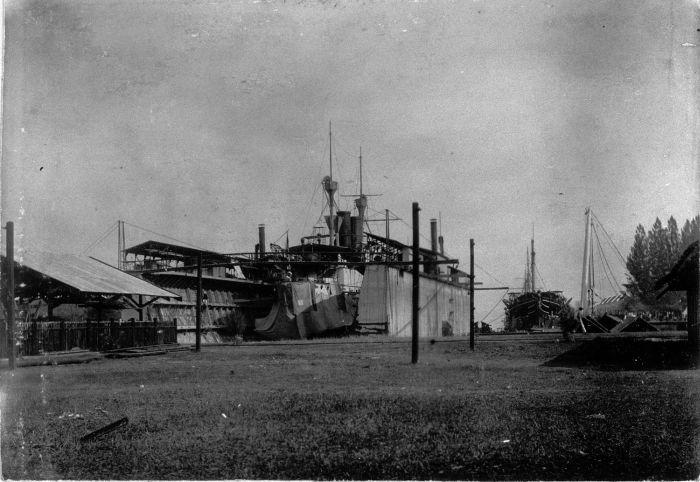Collectie Tropenmuseum no. 60008806. CC By-Sa.
Original caption: armoured corvette lying in the drydock at Surabaya, Dutch East Indies
Laid down at the Koninklijke Fabriek van Stoom- en andere Werktuigen at Amsterdam, Netherlands on 5 March 1888, launched on 26 April 1890, commissioned on 16 March 1891, decommissioned in the Netherlands 10 May 1902, laud up in 1905, stricken in 1906 and on 27 March 1907 sold to be broken up. Part of the Indische Military Marine and served in the Dutch East Indies.
Building costs included preparing for the first time for sea ƒ 1.066.000,00. Steel-built. With a displacement of 1.720 tons were her dimensions 70,00 x 11,30 x 4,35 metres. Her armour consisted of a 3,8cm thick deck and her turret was protected by 15cm. The two steam engines and 4 boilers and two screws made a speed of 12,84 miles possible. Coal bunker capacity 280 tons. The armament consisted of 1-21cm gun, 1-15cm gun, 2-12cm guns, 4-3,7cm guns, 2-3,7cm revolvers, 1-7,5cm mortar and 2 torpedo guns. Her crew numbered 167 men.
The Dutch newspaper Algemeen Handelsblad dated 27 April 1890 described the launching. Built for account of the the Department of Colonies was she originally designed by the shipyard which built her. During the negotiations for ordering her were some details changed although shape, construction and dimensions were not altered. Her designers’ intention was to keep the decrease the weight of the hull without limiting the strength of the construction. For this manner were all plates of the outer hull connected with double strips. Toe be certain that her actual draught was more as the designed one was everything added to the ship weighed. The bow ended in a sharp shaped cast steel made ram while the stern also was made of steel. The steel made turtle back shaped was 23cm thick protecting the engines, boilers, gunpowder and ammunition rooms, the steering device and the electric lightning. A belt protected her sides even below the water level. It consisted of a so-called cells belt consisting of well closed watertight boxes filled with cellulose which while pressed was able to close holes in the hull while pierced by projectiles. In this manner was prevented that large quantities of water could enter the ship. Further more was she fitted out with a double bottom below the boiler room. Watertight bulwarks were placed as protection against incoming water. Both engines were separated from each other by such a bulwark to keep at all times at least one engine working when another was disabled by water or enemy fire. To prevent damage by the well feared white ant was instead of timber thin steel used for the . When this was not possible was chosen for teak. Despite the financial problems of the shipyard was she according to the newspaper one of the finest smaller warships of her time.

